| THIS WEEK'S ARTICLES |
| Larry Williams Focus On Stocks |
| MEMBERS ONLY |
| The False Flag of Fed Rate Cuts | Focus on Stocks: March 2024 |
| by Larry Williams |
|
Let's begin this month with a look at... The False Flag of Fed Rate Cuts Day after day, we hear how the Fed will embark on a series of rate cuts this year "because inflation has peaked" and is heading lower...
|
| READ ONLINE → |
|
|
|
| Art's Charts |
| Spotting Tradable Pullbacks after Trend Reversing Surges |
| by Arthur Hill |
 Most stocks surged with the broader market in the fourth quarter of 2023. SPY and QQQ extended their advances in 2024, but some stocks did not partake and fell back. Even so, some of these stocks show signs of long-term trend reversals and their declines in 2024 look corrective. This week I am focusing on one such stock. Crown Castle (CCI) shows signs of an emerging uptrend and the stock sports a tradable pattern after the pullback. This is our specialty at TrendInvestorPro. Most stocks surged with the broader market in the fourth quarter of 2023. SPY and QQQ extended their advances in 2024, but some stocks did not partake and fell back. Even so, some of these stocks show signs of long-term trend reversals and their declines in 2024 look corrective. This week I am focusing on one such stock. Crown Castle (CCI) shows signs of an emerging uptrend and the stock sports a tradable pattern after the pullback. This is our specialty at TrendInvestorPro.
The chart below shows weekly candlesticks for Crown Castle (CCI) with the 40-week SMA (red) and the 10-week SMA (green). These moving averages are equivalent to the 200 and 50 day SMAs. After an extended downtrend into October 2023, CCI surged above its 40-week SMA in late November and the 10-week SMA followed with a cross in early January. Not only did the 10-week SMA cross the 40-week, but it did so by more than 5%. This strong cross suggests an uptrend is emerging.
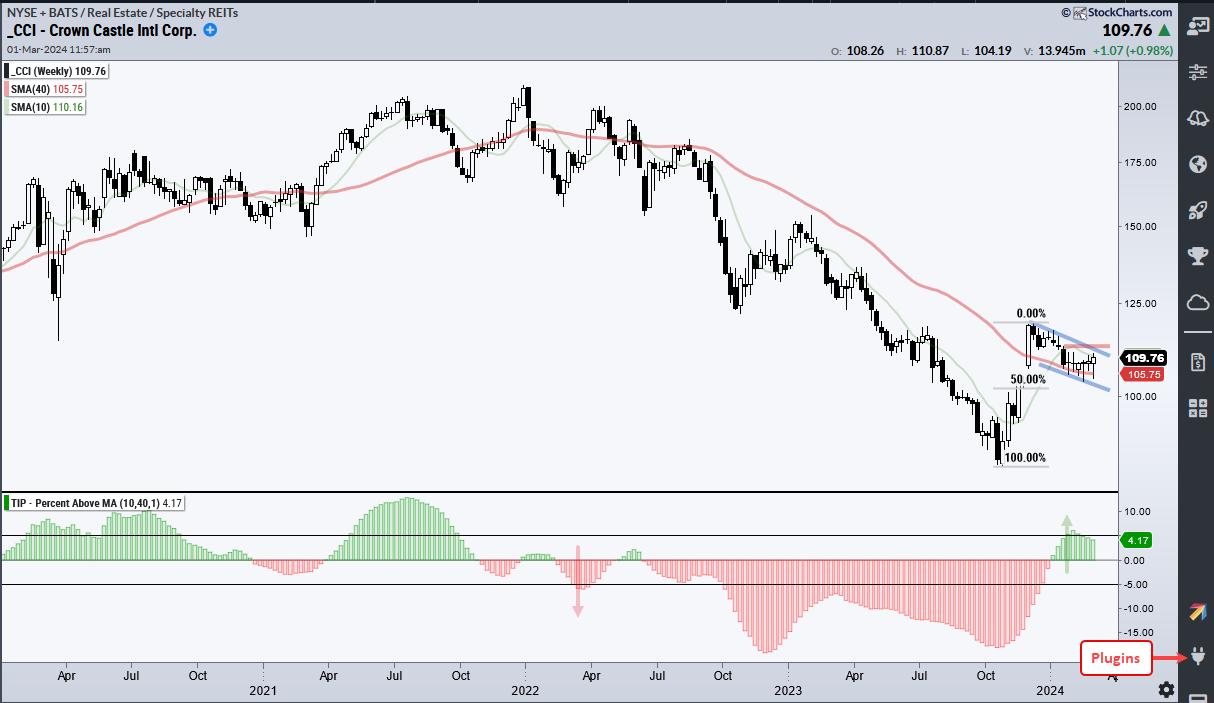
The indicator window shows the percentage difference between the 10-week and 40-week SMAs. I added horizontal lines at +5% and -5% to further filter signals and reduce whipsaws. A move above +5% is bullish and a move below -5% is bearish. This indicator was bullish from May 2017 until March 2022, which is when it crossed below -5%. Percent above MA (10,40,1) then crossed above +5% to turn bullish in early January. Note that this indicator is part of the TIP Indicator Edge Plugin for StockCharts ACP.
A bullish pattern and a breakout would signal a continuation higher. taking shape. CCI surged some 38% from late October to early December and then corrected into February. This decline looks corrective because it retraced half of the prior surge, formed a falling wedge (blue lines) and returned to the 40-week SMA. A 50% retracement (gray lines) is normal after a correction after a sharp advance. Think two steps forward and one step (50%) backward. The 40-week SMA acts as support and the stock firmed just above this moving average the last six weeks. The only thing missing here is a pattern breakout. I am marking resistance at 113 (red line) and a breakout here would be bullish. Upon a breakout, I would re-evaluate on a close below the February lows.
Chart Trader reports and videos focus on stocks and ETFs with uptrends and tradeable patterns. Each week we cover the overall market environment and then feature highly curated trading ideas. This week we covered the Uranium ETF, the Metals & Mining SPDR, CoStar, Zoetis, Cardinal Health and much more. Click here to learn more and get immediate access.
///////////////////////////////////
|
| READ ONLINE → |
|
|
|
| The Traders Journal |
| Your Selling Methodology is Your Paramedic to Profits |
| by Gatis Roze |
"When you feel like bragging, it's probably time to sell." — John Neff
 Stock market investing is simple, really. You only need to make two choices: when to buy and when to sell. The unfortunate reality is that 75% of casual investors really only want to hear about the buy side. So, for those folks, you can stop reading now. This blog is addressed to the other 25%. Stock market investing is simple, really. You only need to make two choices: when to buy and when to sell. The unfortunate reality is that 75% of casual investors really only want to hear about the buy side. So, for those folks, you can stop reading now. This blog is addressed to the other 25%.
First, let me say that relying on your gut feeling that something is not right is a doomed selling methodology. You must always be ready to pull the sell trigger, but you also must know exactly what and why the catalysts are for that sell action to occur.
As I write this blog, the S&P 500 is up 45% over the past 16 months. Re-read John Neff's quote above. The human nature of investors being what it is, we all want to focus on the buy side presently. But precisely for that reason, I believe now is the time to revisit your selling methodology. So for the next couple blogs, think of them as a refresher course on the sell side — this is my invitation for you to revisit your personal selling disciplines.
For the 75% of you that find this topic uninteresting or unnecessary, please re-read my Traders Journal about investing ‘face-plants.' Over decades of teaching investors, the one tool I've used consistently in the classroom that always gets very high accolades from my students is the Action Sequence. I learned it from Dr. Hank Pruden at Golden Gate University, and I've taught the technique ever since in my seminars. The approach is straightforward. I give investors charts and they put pencil to paper — analyzing what's in front of them, and then we analyze them as a group. Within the parameters of this Traders Journal blog, some adjustments obviously need to be made.
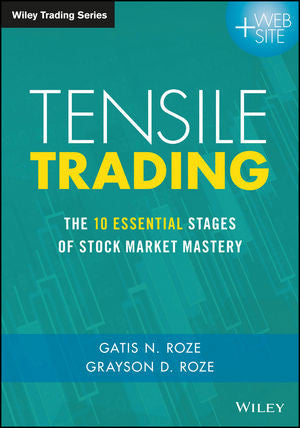 But before tossing charts at you (which I'll do next time), I want you to get up-to-speed on selling. The easiest and fastest way to do that is to give you some homework. Here it is. In our book Tensile Trading: The 10 Stages of Stock Market Mastery, the ninth stage is Selling. Re-reading Chapter 9 will better prepare you for our Action Sequences. Selling exercises to come! But before tossing charts at you (which I'll do next time), I want you to get up-to-speed on selling. The easiest and fastest way to do that is to give you some homework. Here it is. In our book Tensile Trading: The 10 Stages of Stock Market Mastery, the ninth stage is Selling. Re-reading Chapter 9 will better prepare you for our Action Sequences. Selling exercises to come!
This reading assignment will be a good review of the personal investor issues associated with selling your positions, the technical tools we'll use, and the various components you might consider including when assembling your own personal selling methodology. I can help you build it, but it has to be YOUR personal methodology. Otherwise, you won't trust it 100% and you'll be less likely to pull the sell trigger when the best time comes.
Remember that investing is like sports. You can have a tremendous winning streak, but a brief lapse of your attention or discipline can quickly result in losses or giving back a percentage of your profits. Consistency matters. A game plan matters. You'll see how Action Sequence exercises also matter!
Trade well; trade with discipline!
-- Gatis Roze
|
| READ ONLINE → |
|
|
|
| Martin Pring's Market Roundup |
| MEMBERS ONLY |
| Three Intermarket Relationships That Say This Bull Market is Going Higher |
| by Martin Pring |
|
Absorbing the information gleaned from monthly charts for various asset classes or sectors can help gain some perspective. However, I find that an examination of the relationships between them can be equally rewarding, if not moreso...
|
| READ ONLINE → |
|
|
|
| The MEM Edge |
| Small Caps Join The Party -- Here's a Top Stock to Consider |
| by Mary Ellen McGonagle |
The S&P 500 and the NASDAQ both reached an all-time high today boosted by a Tech-fueled rally amid AI-related names. Small-cap stocks also had a bullish day after posting a two-month base breakout to near-term highs. This index has had a tough period recently, as nearly 15% of its stocks are in the Regional Bank group, which is down 9.5% year-to-date. Relatively high interest rates have also hurt, amid higher borrowing costs which lowered the growth outlooks for many of these smaller companies.
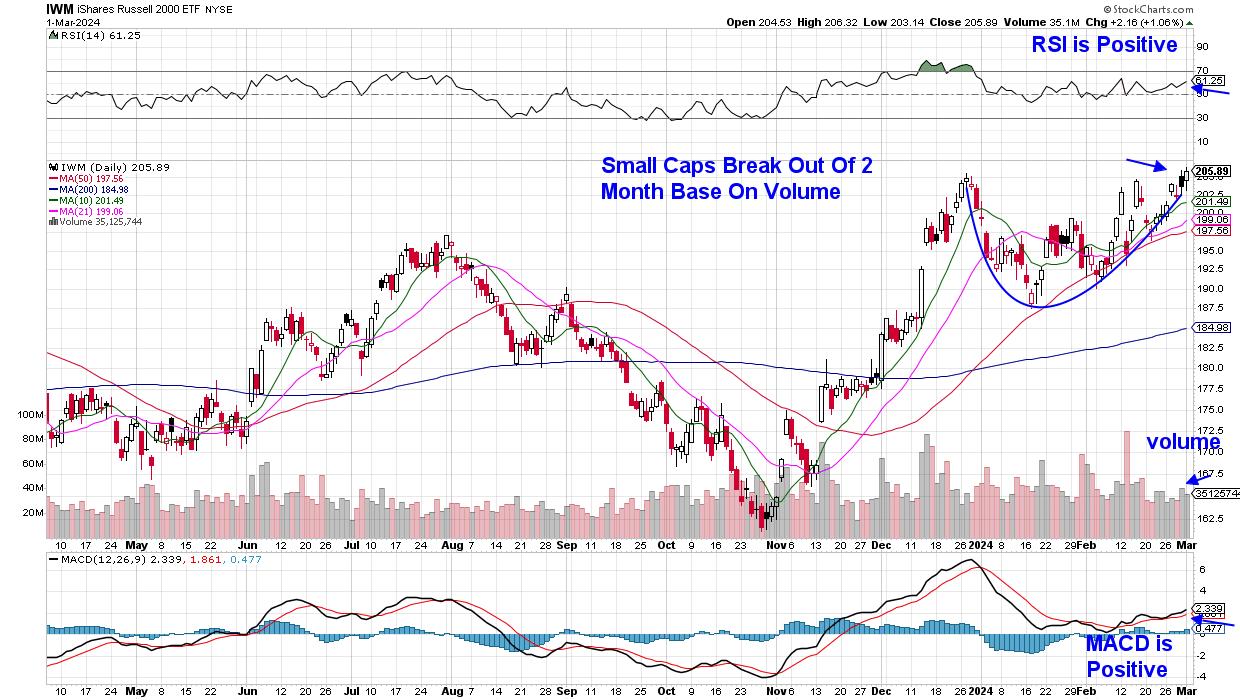 Daily Chart of Russell 2000 Small Cap Index (IWM) Daily Chart of Russell 2000 Small Cap Index (IWM)
Renewed interest in Biotech stocks is one reason for the recent rally in the Russell 2000 Index. This group accounts for 25% of this index, and positive clinical trials, coupled with the anticipation of more mergers of Biotechs with Large Cap Pharmas, has fueled the interest.
Gains in AI-related stocks have also contributed, led by Super Micro Computer (SMCI), which has exploded over the last 2 months. Below is the chart of another noteworthy small-cap tech company - CommVault Systems (CVLT).
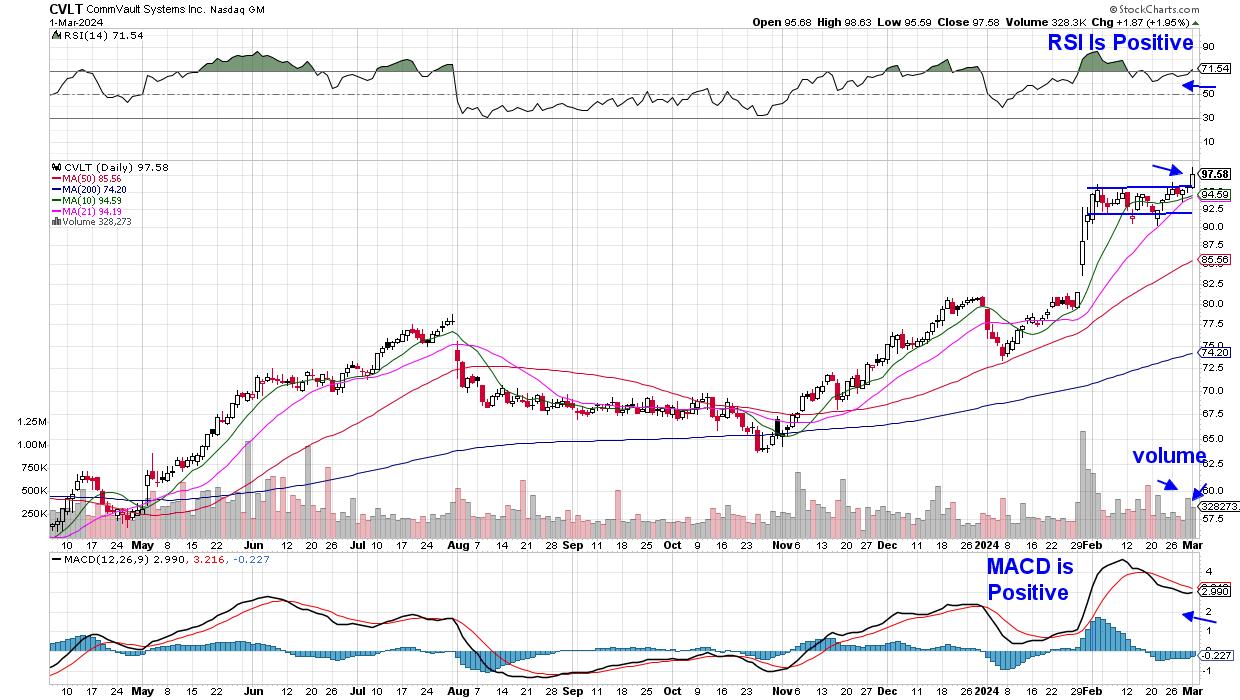 Daily Chart of CommVault Systems (CVLT) Daily Chart of CommVault Systems (CVLT)
The provider of data protection systems, which helps companies recover from cyber attacks, posted one of their best quarterly results ever in late January after seeing subscription revenue gain 29% over last year. CVLT gapped up in price in response, and its four-week period of consolidation has allowed the stock to set up for another leg up.
Small-cap stocks are inherently more volatile, however, so I'd suggest keeping a close eye on the RSI for any hints of more than just a small pullback. With my work, I tend to stick to larger-cap names that can attract institutional money, which can help lead to outsized gains. In fact, my MEM Edge Report identified 4 of the top 5 year-to-date winners in the S&P 500. In addition to adding them to my Suggested Holdings List in November, subscribers were alerted to precise buy points on any pullbacks.
These four outperformers have gains ranging from 34% to 66% over the past 2 months, and they are a part of the twenty other cultivated stocks from my report that are poised to continue to outperform these upward-trending markets.
My twice-weekly MEM Edge Report also provides in-depth information regarding sector rotation and broader market trends. Be sure and use this link here to access a four-week trial at a nominal fee. You'll also have immediate access to prior reports that explain why these winning stocks are trading higher and how to uncover precise buy points.
Warmly,
Mary Ellen McGonagle
MEM Investment Research
|
| READ ONLINE → |
|
|
|
| ChartWatchers |
| Market In a "Wait and See" Mode: Awaiting Important Inflation Data |
| by Jayanthi Gopalakrishnan |

This is a big week for economic data—durable goods, consumer confidence, GDP, and PCE.
Durable goods fell in January, which didn't impact the stock market. Neither did the revised GDP number, which came in slightly lower.
Inflation In Focus
Traders are anxiously awaiting the PCE data to find clues as to when the Fed will likely start cutting interest rates. Treasury yields are a little higher, probably because some of the more recent bond auctions on the 2- and 5-year Notes went well. The US dollar is moving lower.
It's almost as if the stock market has adopted a "wait and see" approach. You'll have to wait until Thursday morning when the PCE comes—will the stock market make a big move in either direction?
Times Are Changing
This week saw some changes in the Dow Jones Industrial Average ($INDU) and Dow Jones Transportation Average ($TRAN). Amazon (AMZN) has joined the Dow, replacing Walgreens Boots Alliance (WBA). It remains to be seen if this addition will help the DJIA's performance, bringing it closer to the performance of the S&P 500. What's interesting is that between announcement and inclusion, stocks that are going to be added to an index tend to rise. After that, the stock price often declines, and the stock that was kicked out tends to do better. AMZN's stock price closed lower today, and the Dow is down about 97 points. But one day doesn't make a trend, so there's no need to sell AMZN.
Uber Technologies' addition to $TRAN is an exciting change, since most companies that make up the $TRAN are shipping and freight companies. The addition of AMZN and UBER into the two Dow Jones indices reflects changing times.
It's interesting to see how $TRAN has performed compared to $INDU (see chart below). While $INDU was hitting new highs, $TRAN was lagging. This goes against one of the tenets of Dow Theory: if $INDU and $TRAN trend in the same direction, the entire stock market trends in a similar direction. $TRAN isn't hitting highs while $INDU continues to hit new highs.
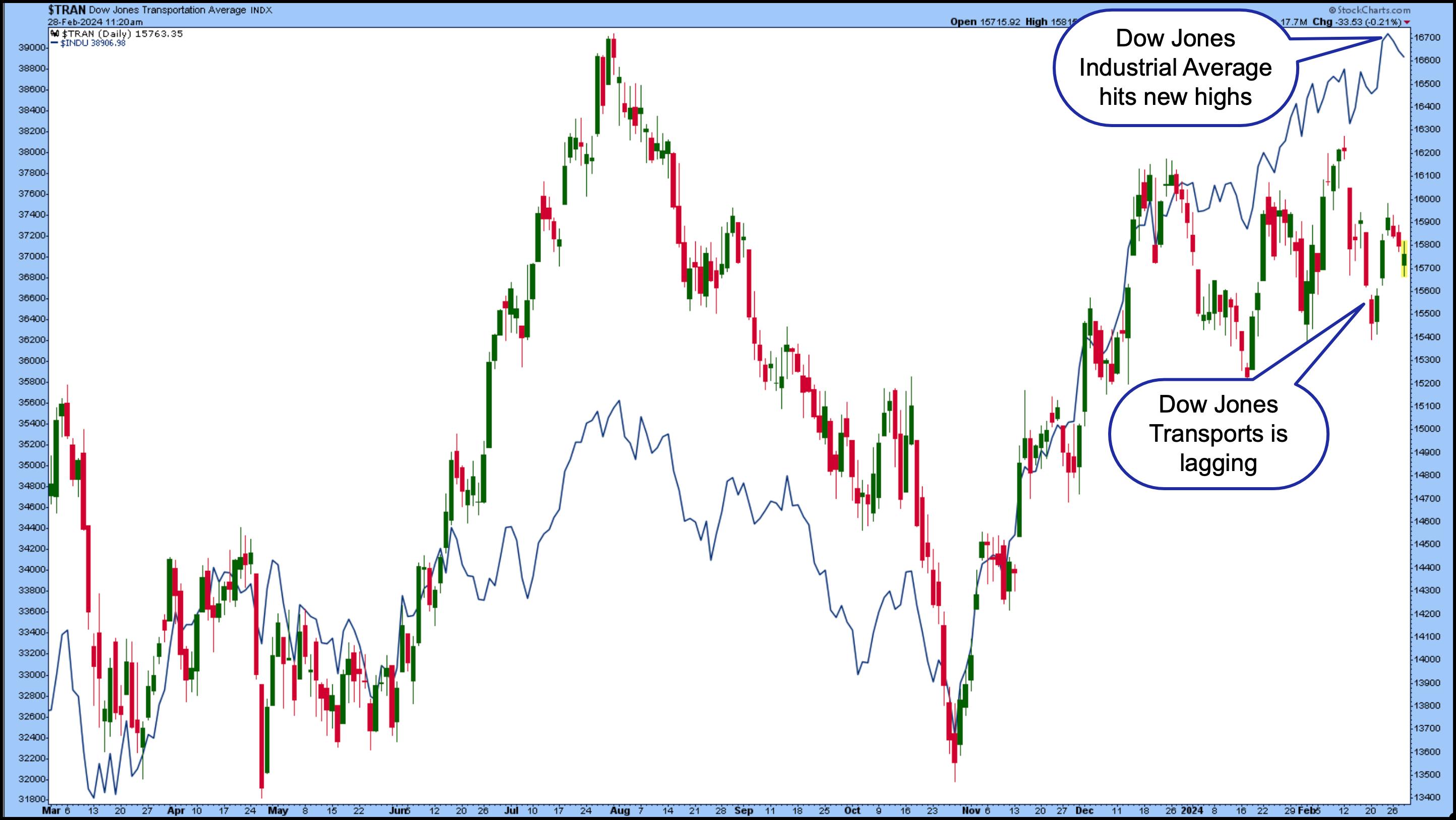
CHART 1. DOW JONES TRANSPORTATION AVERAGE ($TRAN) VS. DOW JONES INDUSTRIAL AVERAGE ($INDU). While $INDU has been hitting new highs this year, $TRAN hasn't been doing the same thing.Chart source: StockCharts.com. For educational purposes.
Meanwhile, in the equity space, chip stocks continue to carry the broader market higher. It's not just NVIDIA (NVDA); Micron Technology (MU) hit a new 52-week high on the news that it's starting high volume production of its High Bandwidth Memory E3 chips. These chips will be incorporated in the Nvidia H200 graphics processing units. Arm Holdings (ARM) has also been soaring this month after its alliance with some big AI players.
Small-Caps Want To Join the Party
While the semiconductors continue to rally, small-cap stocks don't want to get left behind. The weekly chart of the iShares Russell 2000 (IWM) shows it's trying to break above the resistance of a trading range (see weekly chart below). Will it succeed?
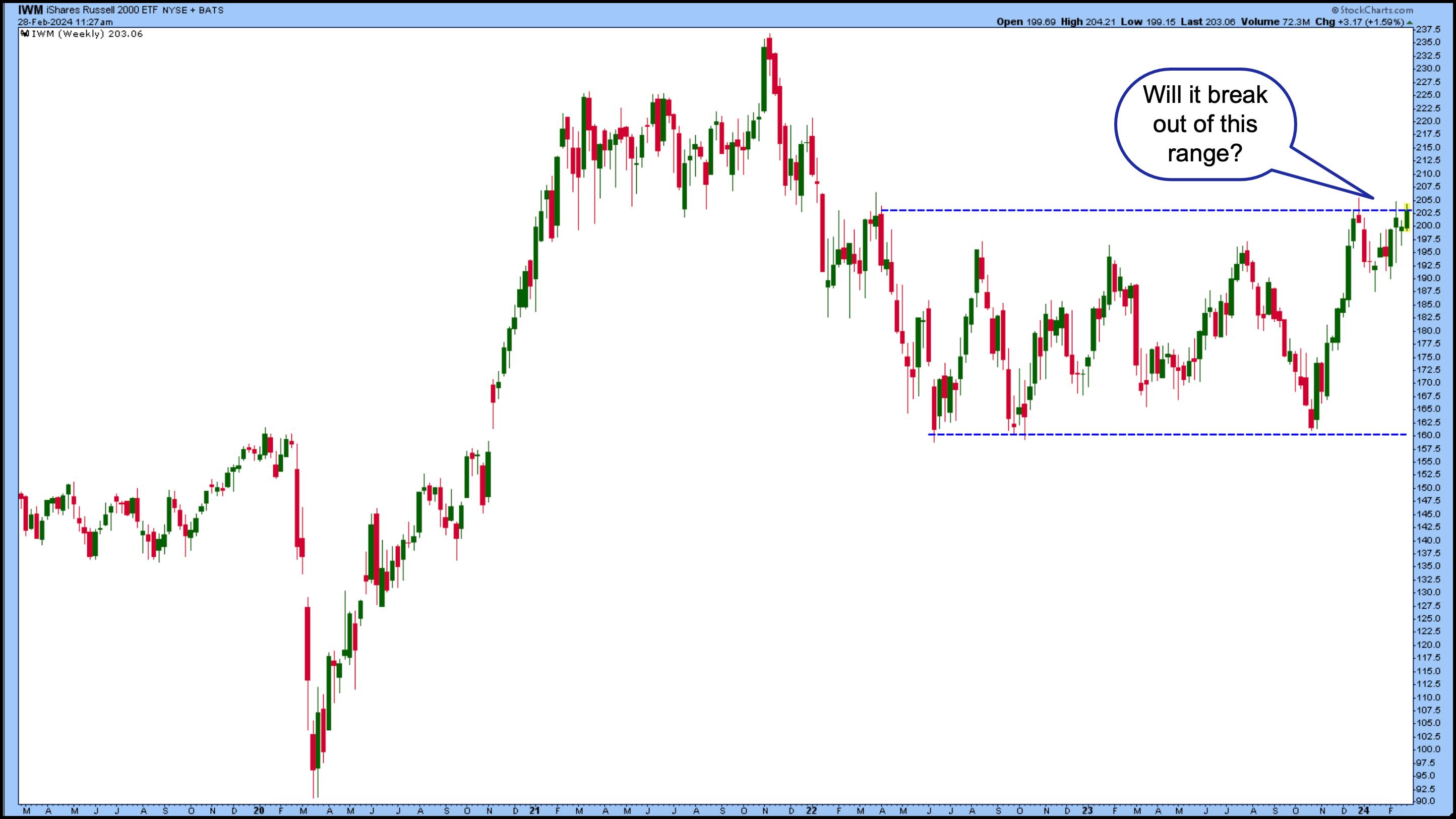
CHART 2. ISHARES RUSSELL 2000 ETF (IWM) CLOSE TO BREAKING OUT OF A RANGE. The big question is, will IWM break out, or will it retreat to its trading range? A lot rests on when the Fed will start cutting interest rates.Chart source: StockCharts.com. For educational purposes.
It's still got a long way to go before hitting its November 2021 high. The first Fed rate cut may be when small caps take off, so monitor the S&P 600 Small Cap Index ($SML) on the StockCharts Market Overview panel (see below).
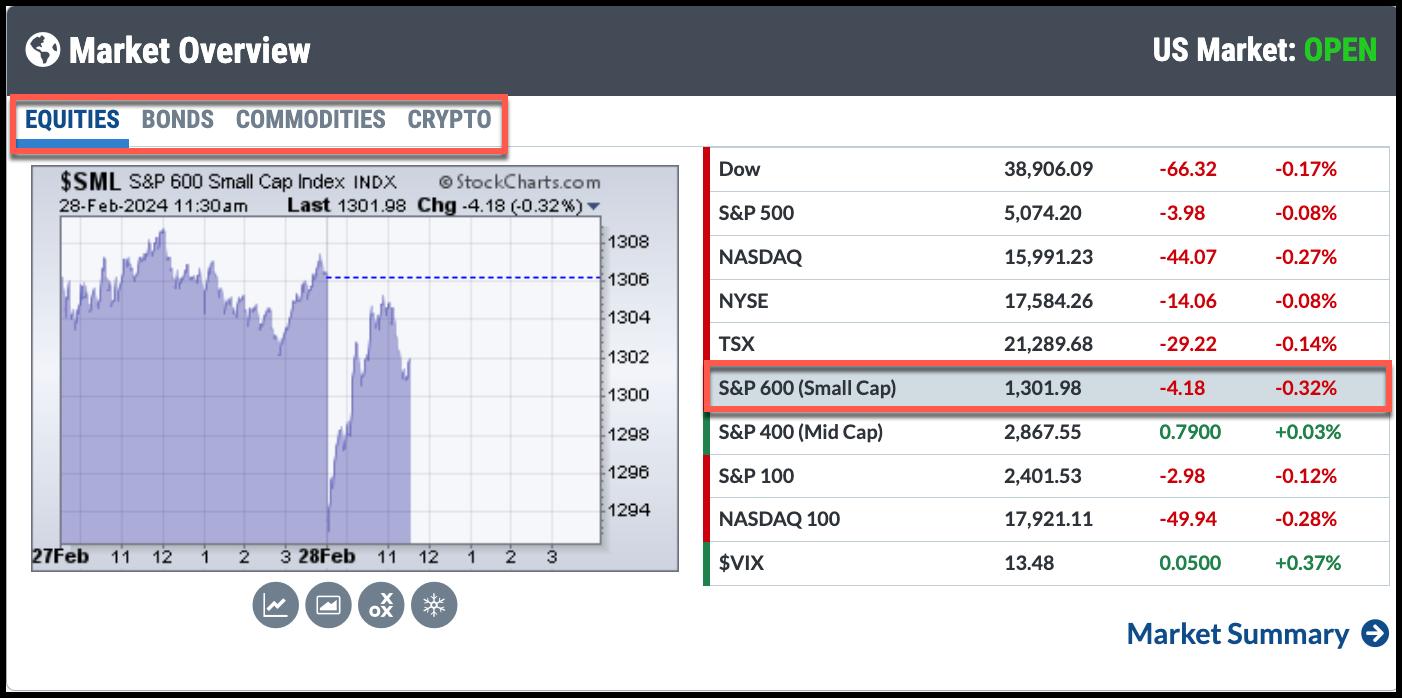

Cool StockCharts Tip.
If you want a bird's eye view of the stock market, select the different tabs in the Market Overview panel—Equities, Bonds, Commodities, and Crypto—to see how the broader market is performing.
And Don't Forget Crypto
One area that's been showing strength is cryptocurrencies. Bitcoin ($BTCUSD) is showing its bullish power this week. It's on tap to have three consecutive big up days (see chart below). This spike has helped stocks like Coinbase (COIN), Marathon Digital (MARA), and Riot Platforms (RIOT) move higher. COIN and MARA hit a new 52-week high today.
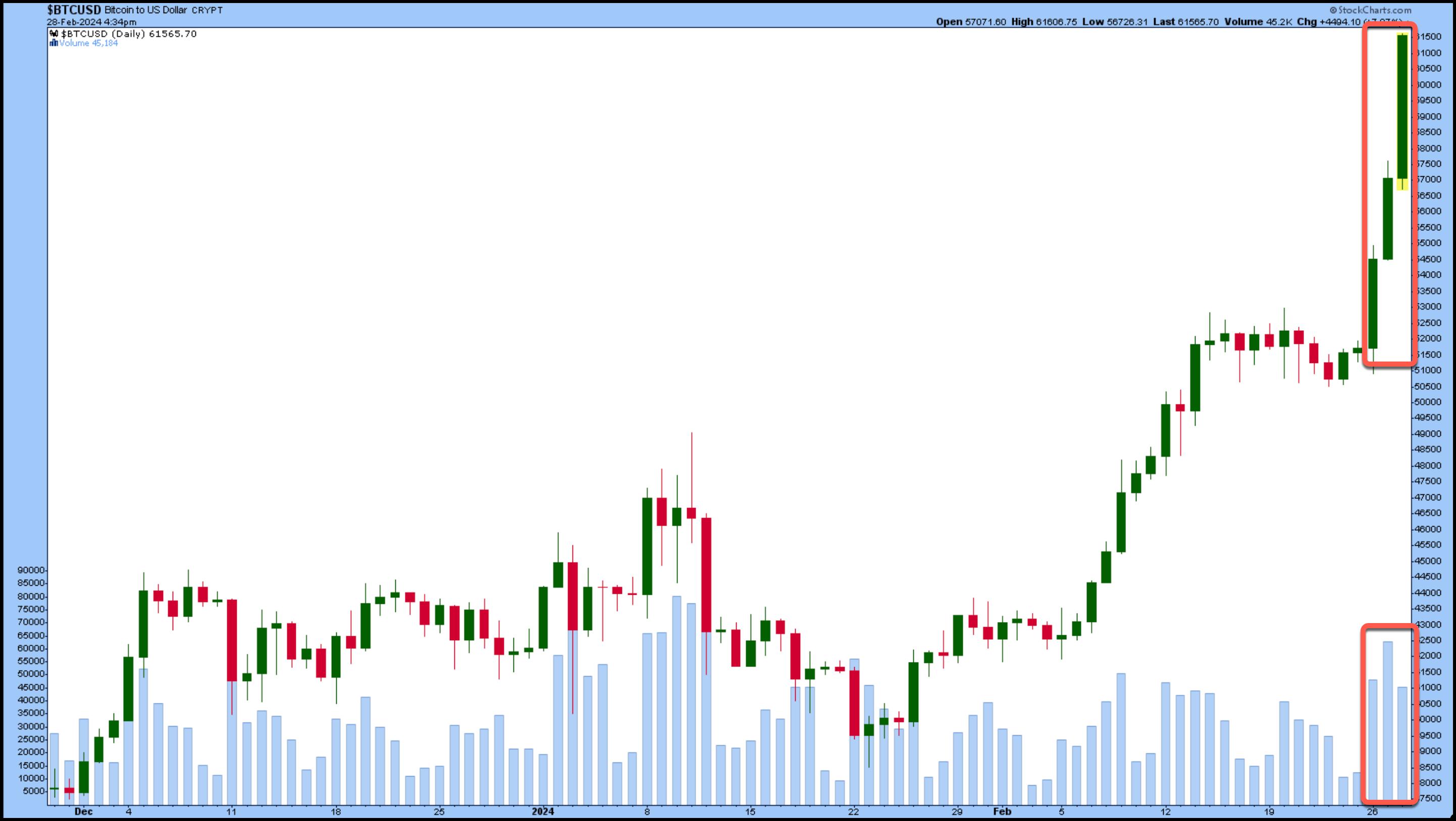
CHART 3. DAILY CHART OF BITCOIN TO US DOLLAR. Three big up days with above-average volume shows this cryptocurrency has momentum. It's not too far away from its all-time high of 69355.Chart source: StockCharts.com. For educational purposes.
The Bottom Line
Equities are rallying, especially due to the AI buzz, so it's probably not the right time to be bearish on equities. The CBOE Volatility Index ($VIX) is still relatively low and shows no signs of investor fear. Thursday's PCE data will probably give the market a reason to move up or down. That's tomorrow morning (Thursday) at 8:30 AM ET. Pre-market trading should provide some clues.

Disclaimer: This blog is for educational purposes only and should not be construed as financial advice. The ideas and strategies should never be used without first assessing your own personal and financial situation, or without consulting a financial professional.
|
| READ ONLINE → |
|
|
|
| DecisionPoint |
| Are the Seven Still Magnificent? |
| by Carl Swenlin |
I have been hearing comments that some of the Magnificent Seven no longer qualify for membership, so I thought a quick look at them might be helpful. For this analysis, I'll be using weekly charts.
Apple (AAPL): AAPL is dealing with trying to move production out of China, and this week it shut down its EV program. The latter will probably have more effect on the EV industry than AAPL, but we'll deal with that when we get to Tesla.
Technically, we have a bearish rising wedge and a PMO negative divergence.
Prognosis: AAPL probably won't be so magnificent for at least a few years.
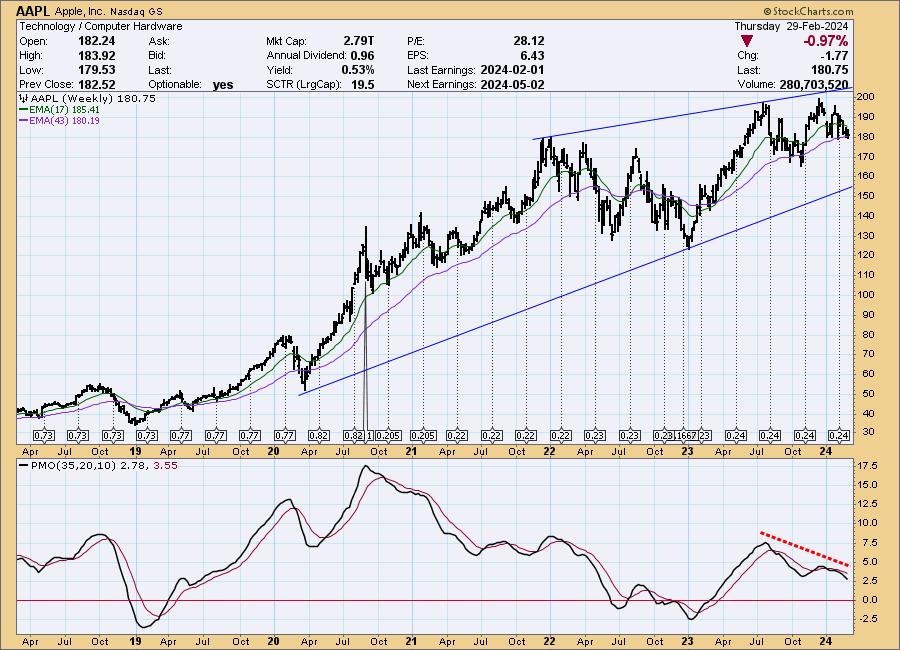
Amazon (AMZN): AMZN suffered mightily during COVID, but it has had a magnificent rally for the last year. The most obvious problem is that it will run into strong resistance at the all-time highs of 2021, and at its current rate of climb, it will hit that resistance in just a few weeks.
Prognosis: Still magnificent, but due to run into long-term resistance.
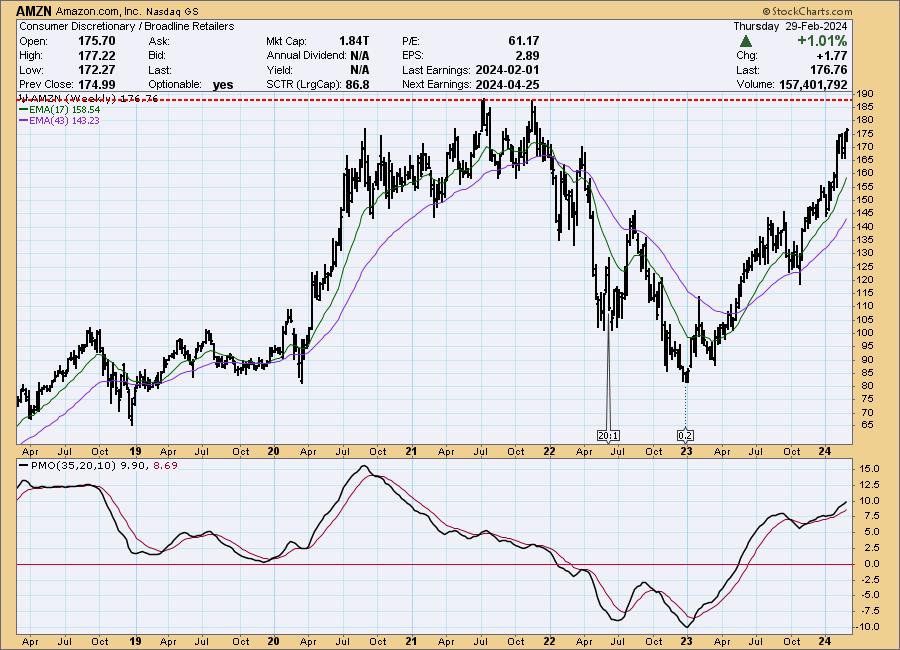
Alphabet (GOOGL): GOOGL has run into resistance at the 2021 top, and has formed a long-term double top. The rising trend line from the 2022 low is still intact, but there is a PMO negative divergence. If that trend breaks, so will its magnificence.
Prognosis: Not good at this point. Magnificence is endangered.
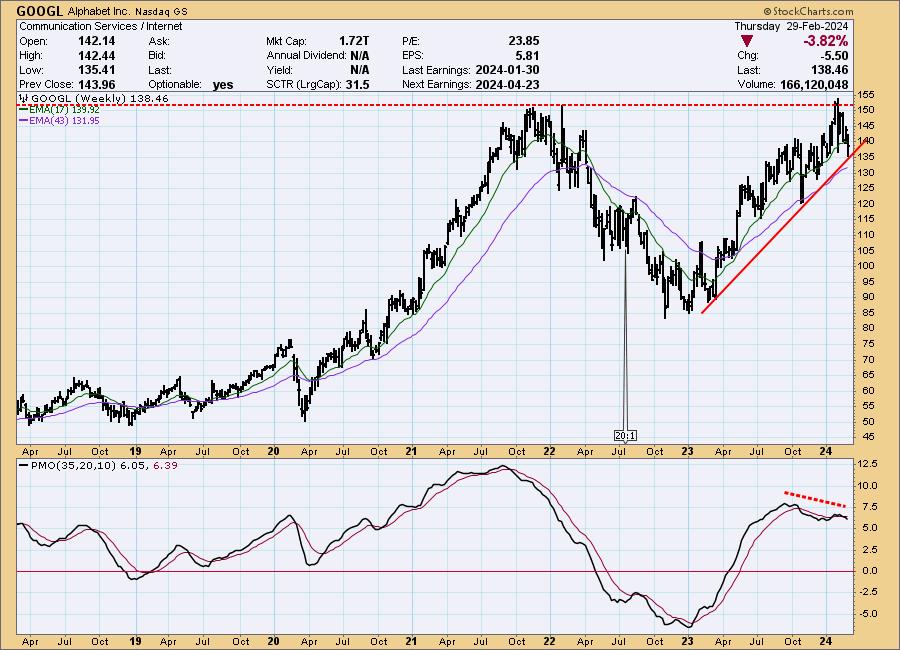
Meta Platforms (META): META was setting up for a long-term double top, but it broke out and is now +28% above that resistance. The problem now is that the advance from the mid-2023 consolidation is parabolic, and vertical up moves beg for correction. There is currently a PMO negative divergence, but the PMO hasn't topped yet and the divergence could be erased.
Prognosis: Still magnificent. Watch out for possible correction.
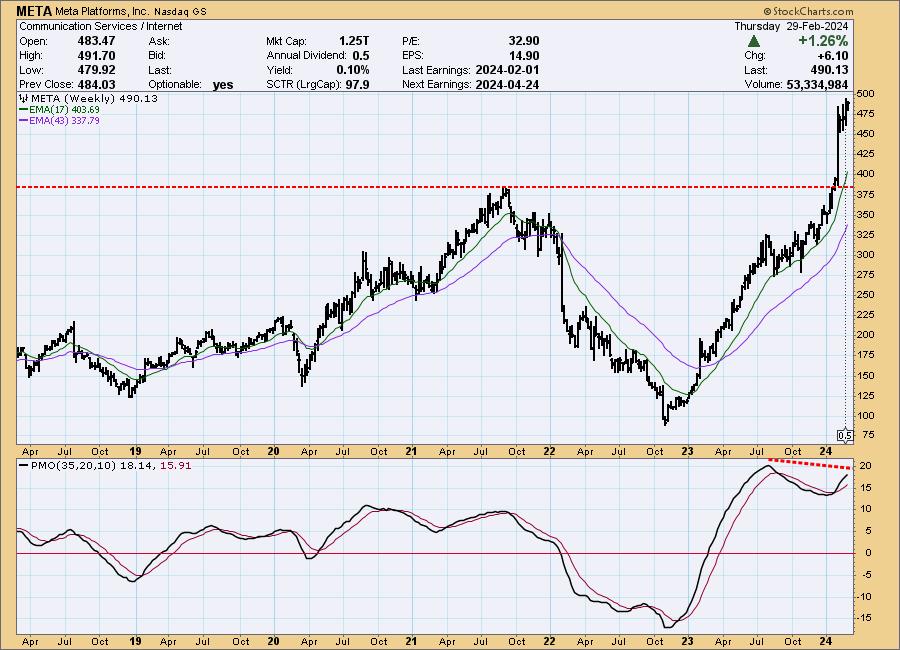
Microsoft (MSFT): MSFT tried to form a double top mid-2023, but it broke out and moved +22% above that resistance. It has formed a long-term bearish rising wedge, and there is a PMO negative divergence, but price movement is strongly bullish.
Prognosis: Magnificent, but with some bearish undertones.
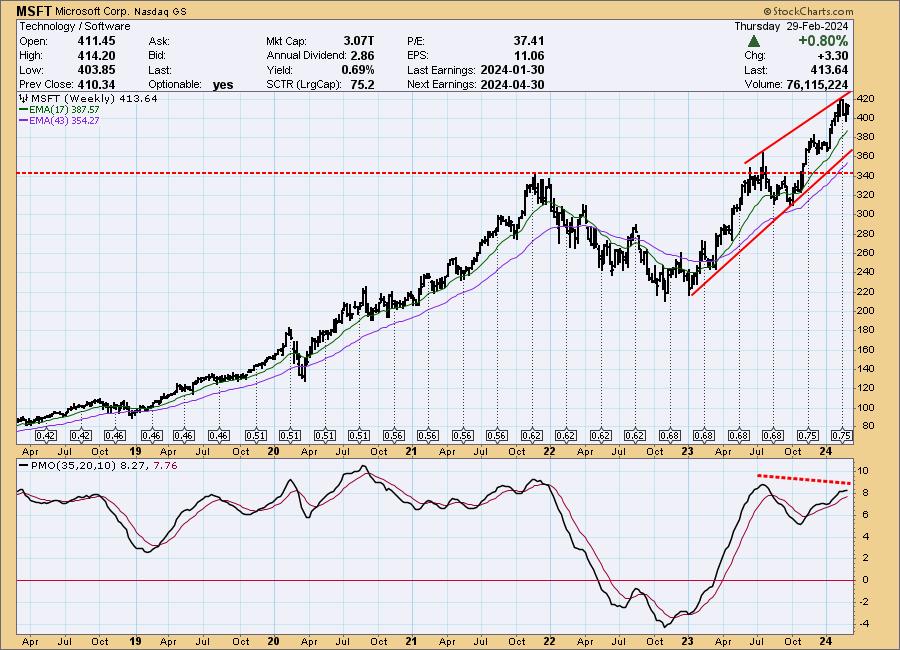
Nvidia (NVDA): NVDA hit resistance at 500 last year and consolidated for about six months. In January, it broke out and moved over +60% above the resistance at 500. Its biggest problem now is the parabolic advance from the 2022 lows. As I said before, parabolic up moves beg for correction.
Prognosis: The most magnificent of the Seven. Correction is likely, but magnificence should prevail.
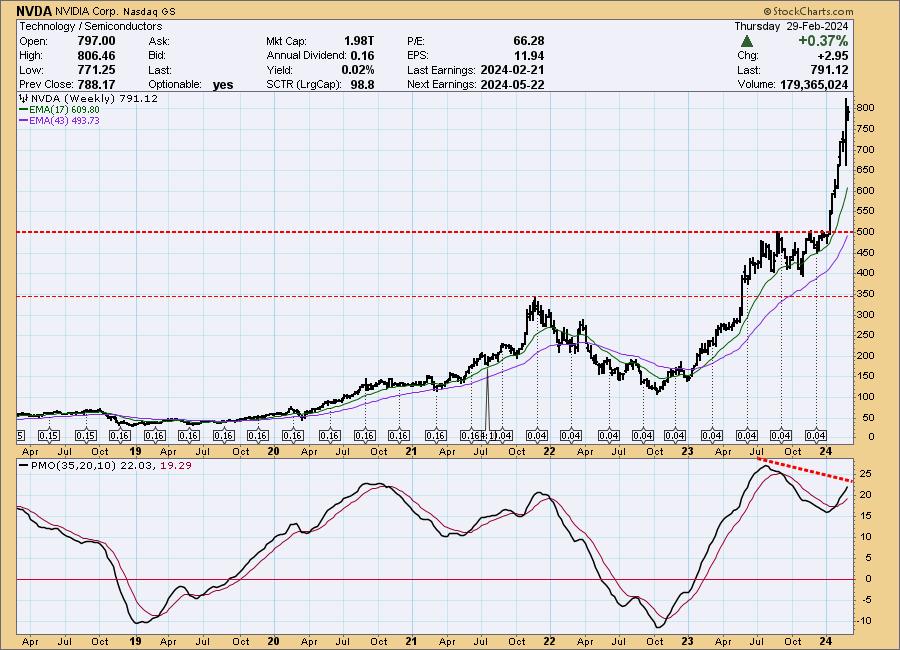
Tesla (TSLA): Apple's recent exit from the EV business is the most dramatic evidence to date of the EV industry and the public's disillusionment with electric vehicles. TSLA is currently -50% down from its 2021 all-time high, and my opinion is that it is not going to recover.
Prognosis: No longer magnificent and probably will not recover.
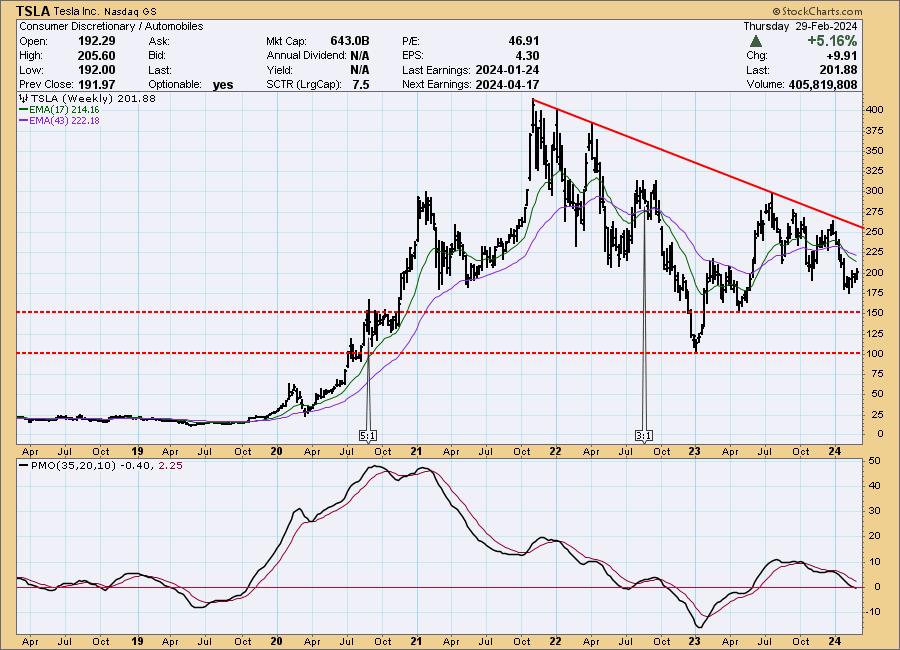
Conclusion: AAPL and GOOGL are fading and, while they are solid businesses, may fall short of magnificence for some years. TSLA is done for. The rest are still magnificent, but with some reservations for the intermediate-term. So, Magnificent Five?
Learn more about DecisionPoint.com:
Watch the latest episode of the DecisionPointTrading Room on DP's YouTube channel here!

Try us out for two weeks with a trial subscription!
Use coupon code: DPTRIAL2 at checkout!
Technical Analysis is a windsock, not a crystal ball. --Carl Swenlin
(c) Copyright 2024 DecisionPoint.com
Disclaimer: This blog is for educational purposes only and should not be construed as financial advice. The ideas and strategies should never be used without first assessing your own personal and financial situation, or without consulting a financial professional. Any opinions expressed herein are solely those of the author, and do not in any way represent the views or opinions of any other person or entity.
DecisionPoint is not a registered investment advisor. Investment and trading decisions are solely your responsibility. DecisionPoint newsletters, blogs or website materials should NOT be interpreted as a recommendation or solicitation to buy or sell any security or to take any specific action.
Helpful DecisionPoint Links:
Trend Models
Price Momentum Oscillator (PMO)
On Balance Volume
Swenlin Trading Oscillators (STO-B and STO-V)
ITBM and ITVM
SCTR Ranking
Bear Market Rules
|
| READ ONLINE → |
|
|
|
| Trading Places with Tom Bowley |
| Evaluating Risk is a Key Difference Between Successful and Unsuccessful Traders |
| by Tom Bowley |
This secular bull market advance is running over everyone attempting to get in its way. It's why I always say never to bet against one. Trying to short this type of bull market is the equivalent of financial suicide. I usually have music playing in the background while I'm working and, on Friday, as the stock market closed, Elton John's "I'm Still Standing" started playing. I thought, "WOW, this is timely!" EVERYTHING has been thrown at this secular bull market and it's still standing, "better than it ever did."
Resiliency is a key element of bull market moves and we've certainly witnessed that. But, bull market or not, we absolutely should lower our bar of expectations right now. I would definitely remain fully invested, but just try not to grow too bearish when we inevitably enter a period of consolidation or (gasp!) selling. The first half of calendar quarters 1-3 is historically MUCH more bullish than the second half of calendar quarters 1-3. During the current secular bull market that began in 2013, here's the S&P 500 breakdown by annualized returns by calendar quarters 1-3:
- 1st half of calendar quarters 1-3: +18.14%
- 2nd half of calendar quarters 1-3: -3.37%
That's a very large discrepancy in performance and it's calculated over 11+ years of data. We know what's been driving our major indices higher. It's been the Magnificent 7 and friends. In a 70-page Seasonality PDF that I've offered to everyone on 16 of the largest market cap companies, a TON of seasonal information was shared on each. Following the theme of 1st half vs. 2nd half of calendar quarters, let me share with you the annualized returns for both halves for each of these 16 companies:
1st Half of Calendar Quarters 1-3:
- AAPL: +50.54%
- MSFT: +37.67%
- GOOGL: +50.42%
- AMZN: +51.51%
- NVDA: +75.63%
- META: +56.44%
- TSLA: +62.69%
- AVGO: +18.26%
- COST: +25.50%
- ADBE: +33.82%
- CSCO: +18.85%
- AMD: +72.48%
- NFLX: +47.21%
- INTC: -1.11%
- AMGN: +21.81%
- SBUX: +17.13%
2nd Half of Calendar Quarters 1-3:
- AAPL: +9.52%
- MSFT: +12.35%
- GOOGL: -8.70%
- AMZN: +13.29%
- NVDA: +47.80%
- META: +8.93%
- TSLA: +40.41%
- AVGO: +40.21%
- COST: +9.64%
- ADBE: +20.37%
- CSCO: +2.69%
- AMD: +26.77%
- NFLX: +19.45%
- INTC: +13.98%
- AMGN: +2.52%
- SBUX: -4.05%
Of these 16 stocks, only AVGO and INTC perform better during the 2nd halves of quarters.
I deliberately ignored Q4, because this quarter has a long history of seeing considerable strength during both halves. But in quarters 1-3, we should simply recognize the historical patterns and be sure to lower our expectations, especially after such a significant rally since late-October 2023.
We're still seeing a "risk on" market environment, which favors the bulls. If we begin to see relative strength in more defensive sectors, that could be the signal to perhaps take on less risk. Using StockCharts.com's seasonality tool, we can compare defensive utilities (XLU) vs. ultra-aggressive technology (XLK) since 2013:
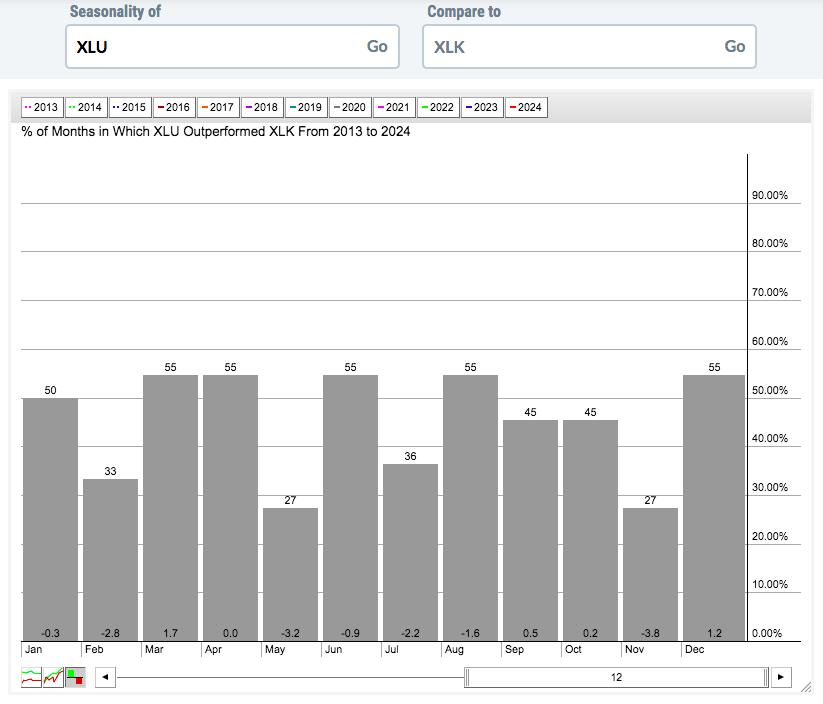
Utilities don't outperform technology very often, but it seems to happen somewhat frequently in the 3rd months of calendar quarters. Check out March, June, September, and December above. March is the best calendar month for XLU outperformance vs. the XLK. But the second months, February, May, August, and November, favor technology in a HUGE way!
Now let's look at consumer staples (XLP, defensive) vs. consumer discretionary (XLY, aggressive), using the same seasonality chart since 2013:
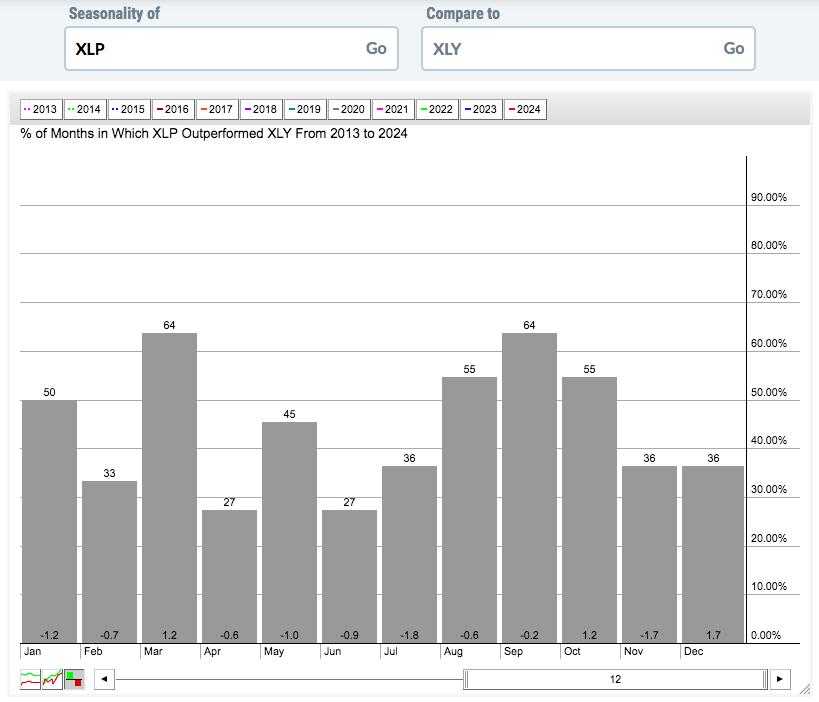
Again, it's the third months of calendar quarters where defensive areas show some relative strength and the second months where we've seen MASSIVE relative weakness. We need to recognize these seasonal patterns to become better traders, knowing when it's appropriate to take on more risk.....and when it's not.
Based on all of this, it seems rather prudent to me to be a bit more cautious now. I'm not at all saying that our major indices are primed for a big fall. Instead, I'm simply pointing out that we're in a time of the year when risk does escalate. It's up to each individual as to what that might mean in your own trading and/or investing.
By the way, I am still offering the "Bowley Trend", our seasonal PDF, for FREE. CLICK HERE and claim your copy!
Happy trading!
Tom
|
| READ ONLINE → |
|
|
|
| ChartWatchers |
| Flip the Script: Defense as Your New Offensive Playbook |
| by Karl Montevirgen |

Historical and seasonal performance data indicate that the Utilities and Consumer Staples sectors can be effective growth instruments, particularly in March. Technical analysis of the current price action for Utilities Select Sector SPDR Fund (XLU) and Consumer Staples Select Sector SPDR Fund (XLP) supports the thesis that these sectors are poised for growth, offering traders potentially favorable entry points for capitalizing on this seasonal trend.
If the best defense is a strong offense, then sometimes the most effective offense is a defensive tactic used offensively (as Napoleon did when he used the divisional square tactic in the Battle of the Pyramids). It's a matter of proper placement and timing.
The same can be said when it comes to shifting growth vs. defensive tactics in your trades. Specifically, this article focuses on exploiting the Utilities and Consumer Staples sectors as growth instruments. It's a matter of timing.
Exploiting Seasonal Growth Opportunities Using Defensive Sectors?
This article takes its queue and slight diversion from Tom Bowley's insightful article, where he discusses the risk-on and risk-off environment, comparing XLU and XLP with the "ultra-aggressive" Technology Select Sector SPDR Fund (XLK), a Tech sector proxy. Bowley makes a compelling and balanced case to consider risk and caution as the current bull market continues to reach new heights.
This piece takes a bit of a diversion. Here's the argument: From a seasonality perspective, March is XLU's best month for growth and XLP's second-best month for growth. In short, these two defensive plays happen to bring out their most aggressive characteristics (on a seasonal basis) in the month of March.
XLU's 10-Year Seasonal Performance Against the S&P 500

CHART 1. 10-YEAR SEASONALITY CHART OF XLU VS S&P 500. Against the broader market, March is XLU's strongest month.Chart source: StockCharts.com. For educational purposes.
On average and over 10 years, the Utilities sector (XLU) has outperformed the S&P 500 with an 89% higher-close rate and a 2.9% average return in March. Looking at all 12 months, you will not find a better-performing month than March.
XLP's 10-Year Seasonal Performance Against the S&P 500

CHART 2. 10-YEAR SEASONALITY CHART OF XLP VS S&P 500. March is XLP's second-strongest performance against the S&P following December.Chart source: StockCharts.com. For educational purposes.
On average, over 10 years, XLP has outperformed the S&P 500 with a 56% higher-close rate and a 1.3% average return in March. The average higher-close and return rates are strongest in December, but March is XLP's second-best performing month.
Using "Safe" Plays as a "Bold" Move
Similar to the analogy mentioned above—using a defensive tactic to achieve an aggressive outcome—might it be prudent to shift trading focus to a "caution play" to get ahead of the broader market? Historically and seasonality-wise, this has played out well on average in the last 10 years, but whether the odds are in your favor this year really depends on the whims of market sentiment and whether you can find a sensible entry point in the current price environment.
After all, March is only a few days away.
XLU's Price Action Now

CHART 3. DAILY CHART OF XLU. The swing chart makes directionality and entry/exit points clear.Chart source: StockCharts.com. For educational purposes.
The last two lower lows in January and February coincided with a rise in buying pressure, as indicated by the Money Flow Index (MFI), which you can also think of as a volume-weighted RSI. The bullish divergence between declining prices and increasing buying pressure foreshadowed this month's price rise.
If you take a look at the ZigZag lines, you can see the swing points that define the trend. So, if XLU reverses course and rises to fulfill its seasonality-based projection, it would have to break above the two swing highs (see green dotted lines) at $62.25 and $62.62 to break the current downtrend. It would also have to stay above the most recent swing low (see red dotted line) at $59.15.
If you want to go long XLU, a break above $62.25 on high momentum might be a favorable entry point.
XLP's Price Action Now

CHART 4. DAILY CHART OF XLP. Just sailing with no clouds in sight? Otherwise, a seemingly boring chart.Chart source: StockCharts.com. For educational purposes.
Consumer Staples (XLP) appears to be chugging along rather serenely. Looking at the Relative Strength Index (RSI), XLP is neither overbought nor oversold. It's just there in the middle. To get a clearer and volume-weighted reading, look at the Money Flow Index (MFI), which shows pretty much the same thing but with a slight upward tilt, indicating a slight rise in buying pressure.

The chart plots a trendline to show the main trend plus a Kumo (Ichimoku Cloud) for secondary context. Based on all of these readings, XLP gives every indication that it's heading higher. So, if you're looking to go long XLP to take advantage of its seasonality-based expectations, getting in a position near the trendline, say, $73.50 might be a favorable spot. You don't want to see price fall below the trendline, and a close below $72.36, its most recent swing low, would likely invalidate the bullish thesis.
The Bottom Line
The strategic exploitation of Utilities (XLU) and Consumer Staples (XLP) sectors for seasonality-based opportunities is an interesting case in which you'd use defensive tools to seek growth. The timing, as with all trades, is crucial, and the coming month of March, historically the strongest for these sectors, offers a unique window for this strategy. Of course, seasonality is never a sure thing, so if you're planning on pursuing this opportunity, be ready to exit upon the first indications that this season might not follow historical patterns.
Disclaimer: This blog is for educational purposes only and should not be construed as financial advice. The ideas and strategies should never be used without first assessing your own personal and financial situation, or without consulting a financial professional.
|
| READ ONLINE → |
|
|
|
| MORE ARTICLES → |
|



 Most stocks surged with the broader market in the fourth quarter of 2023. SPY and QQQ extended their advances in 2024, but some stocks did not partake and fell back. Even so, some of these stocks show signs of long-term trend reversals and their declines in 2024 look corrective. This week I am focusing on one such stock. Crown Castle (CCI) shows signs of an emerging uptrend and the stock sports a tradable pattern after the pullback. This is our specialty at
Most stocks surged with the broader market in the fourth quarter of 2023. SPY and QQQ extended their advances in 2024, but some stocks did not partake and fell back. Even so, some of these stocks show signs of long-term trend reversals and their declines in 2024 look corrective. This week I am focusing on one such stock. Crown Castle (CCI) shows signs of an emerging uptrend and the stock sports a tradable pattern after the pullback. This is our specialty at 
 Stock market investing is simple, really. You only need to make two choices: when to buy and when to sell. The unfortunate reality is that 75% of casual investors really only want to hear about the buy side. So, for those folks, you can stop reading now. This blog is addressed to the other 25%.
Stock market investing is simple, really. You only need to make two choices: when to buy and when to sell. The unfortunate reality is that 75% of casual investors really only want to hear about the buy side. So, for those folks, you can stop reading now. This blog is addressed to the other 25%. But before tossing charts at you (which I'll do next time), I want you to get up-to-speed on selling. The easiest and fastest way to do that is to give you some homework. Here it is. In our book
But before tossing charts at you (which I'll do next time), I want you to get up-to-speed on selling. The easiest and fastest way to do that is to give you some homework. Here it is. In our book 
































